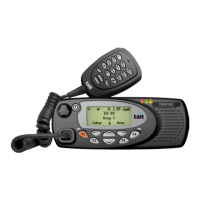TM9100 Service Manual Transmitter Fault Finding (25W Radios) 363
© Tait Electronics Limited August 2005
Task 30 —
Repair Circuitry
If the RF output power measured in Task 29 is low, there is a fault in the
circuit between the common drain of the PAs and the test capacitor.
1. If not already done, remove the
PAF TOP can.
2. Check for faulty, shorted or misplaced components in the circuit
between the test capacitor and the common drain of Q309 and Q310
(see Figure 12.6 to Figure 12.7).
3. Repair any fault revealed by the above checks and go to Step 5. If no
fault could be found, go to Step 4.
4. Remove the test lead and test capacitor, resolder the coupling
capacitors C348, C349 and C350 in position (see Figure 12.17),
and go to Task 25
.
5. With the test lead still connected to the test set, enter the CCTM
command 326 5 to set the transmitter power level to the maximum.
6. Enter the CCTM command 101 x x 0, where x is the lowest
frequency (in hertz) for maximum power, as given in Table 12.8
(B1 band) or Table 12.9 (H5, H6).
7. Enter the CCTM command 33 to place the radio in transmit mode.
8. Measure the RF output power. This should exceed 35 W.
9. Enter the CCTM command 32 to place the radio in receive mode.
10. Enter the CCTM command 101 x x 0, where x is the highest
frequency (in hertz) for maximum power, as given in Table 12.8
(B1 band) or Table 12.9 (H5, H6).
11. Repeat Steps Step 7 to Step 9.
12. Remove the test lead and test capacitor, and resolder the coupling
capacitors C348, C349 and C350 in position (see Figure 12.17).
13. If the power in both the above cases is now correct, the fault has been
rectified; go to “Final Tasks” on page 147. If it is not, the repair
failed; replace the main-board assembly and go to “Final Tasks” on
page 147.
RF output power: more than 35W

